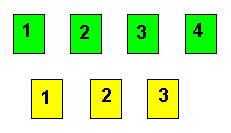
Lesson 3.3 Addition and Multiplication Rules
Addition Rule
A and B are events. The Addition Rule is:
P(A OR B) = P(A) + P(B) - P(A AND B)
Example: In a box that you cannot see into are
three yellow cards numbered 1, 2, 3 and four green
cards numbered 1, 2, 3, 4. The experiment is to
randomly draw one card.
Let Y = yellow card and G = green card. Each card
is equally likely and the sample space is {Y1, Y2,
Y3, G1, G2, G3, G4}. There are 7 cards in the
sample space.

What is the probability of drawing a green card
OR a card with a 1 on it?
There are 4 green cards (G1, G2, G3, G4) and 2
cards with a 1 (Y1, G1). Notice that G1 is
repeated.
P(green card) = 4/7
P(card with a 1) = 2/7
P(card that is both green card and has a 1) = 1/7
If G = green card and H = card with a 1, then:
P(G OR H) = P(G) + P(H) - P(G AND H)
P(G OR H) = 4/7 + 2/7 - 1/7 = 5/7
When we add P(G) and P(H), we have counted G1
twice. G AND H refers to card G1. So, when we
calculate P(G OR H), we must subtract one
occurrence of card G1. That is the reason we must
subtract P(G AND H).
The Addition Rule And
Mutually Exclusive
If A and B are mutually exclusive,
then P(A AND B) = 0 and the Addition Rule
becomes:
P(A OR B) = P(A) + P(B)
Example: A and B are mutually exclusive events.
P(A) = 0.05 and P(B) = 0.62. Find P(A or B).
Since A and B are mutually exclusive, the
Addition Rule is P(A OR B) = P(A) + P(B) = 0.05 +
0.62 = 0.67.
Multiplication Rule
A and B are events. The Multiplication Rule is
P(A AND B) = (P(A))(P(B |A)) or
P(A AND B) = (P(B))(P(A | B))
Example: P(A) = 0.3, P(B) = 0.12, and P(B | A) =
0.2.
Then P(A AND B) = (P(A))(P(B | A)) =
(0.3)(0.2) = 0.06.
Now find P(A | B).
Since P(A and B) = (P(B))(P(A | B)), divide both
sides of this equation by P(B). Then,
P(A | B) = P(A and B) / P(B) = 0.06 / 0.12 = 0.5.
The Multiplication Rule
and Independence
If A and B are independent, then
P(A | B) = P(A) and P(B | A) = P(B). This means
that A does not depend on B and B does not depend
on A. The Multiplication Rule becomes:
P(A AND B) = (P(A))(P(B))
Example: Toss 2 fair coins. What is the
probability of getting 2 tails?
 
Since the toss of the second coin does not depend
on the toss of the first coin,
P(2 tails) = P(tail AND tail) =
(P(tail))(P(tail)) = (1/2)(1/2) = 1/4.
Other Probability Problems
Example
The example
illustrates the addition and multiplication rules,
mutually exclusive, and independence.
Please continue to the next section
of this lesson.
Up » 3.1
Terminology »3.2 Independent or
Mutually Exclusive »
3.3 Addition and Multiplication Rules » 3.4
Contingency Tables
|